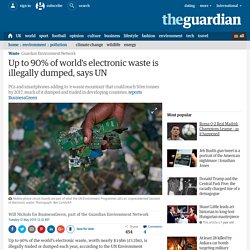

e-waste
Which Country Is On Top Of The World's Electronic Waste Mountain? [Infographic] - Forbes. 2014 saw a record amount of electronic waste discarded across the globe, according to a report compiled by the United Nations University. 41.8 million tons of refrigerators, televisions, washing machines, vacuum cleaners and other electrical appliances were thrown away last year, up from 39.8 million in 2013.
![Which Country Is On Top Of The World's Electronic Waste Mountain? [Infographic] - Forbes](http://cdn.pearltrees.com/s/pic/th/electronic-infographic-115586344)
Last year’s mountain of e-waste is equivalent to 1.15 million heavy trucks forming a line 14,300 miles long, according to the report. Waste that could have been recovered for recycling contained an estimated 16,500 kilotons of iron, 1,900 kilotons of copper and 300 tons of gold, worth $52 billion. The United States and China generated the most e-waste last year – 32 percent of the world’s total. However, on a per capita basis, several countries famed for their environmental awareness and recycling records lead the way. Norway is on top of the world’s electronic waste mountain, generating 62.4 lbs per inhabitant. *Click below to enlarge (charted by Statista) The e-Waste Issue in Australia - Greensense.
4 Flares Twitter 0 Facebook 3 LinkedIn 1 inShare Google+ 0 4 Flares × e-Waste is any electronic equipment that is no longer useful as originally intended. e-Waste includes computers, mobile phones, televisions, fax machines, etc.

This waste may be donated or sold for re-use, recycled, or disposed of, ending up in landfill. When e-waste ends up in landfill, many different environmental issues are encountered, due to the materials it contains. International studies show that 70% of heavy metals (e.g. lead, mercury, cadmium) in all landfill come from e-waste. Agbogbloshie: The largest e-waste dumping site in the world. Old monitors are used to build bridges.

Picture: Kevin McElvaney Source: Supplied Loaded: 0% Progress: 0% Teach your kids about the importance of recycling by reusing some stuff from your recycling bin. WHEN you throw out your television, you expect it to be recycled properly. Due to the toxic chemicals in electronic appliances — TVs, computers, stereo systems, refrigerators — the cost of disposing of such items correctly is costly and dangerous. John Mahama, 21, suffers from insomnia and has debilitating headaches, but continues to work. Containers leave the West labelled “development aid” or “second-hand products” but in fact destroy the environment and lives when they land illegally in Tema Harbour, Ghana.
Cows with open wounds still graze their previous home. Guiyu: An E-Waste Nightmare. Nowhere is the environmental impact of e-waste as apparent as in Guiyu, Guangdong province.

Here the water is black and acidic, children have lead poisoning and the fumes of chemicals hang heavy in the air. A small Chinese child sitting among cables and e-waste, Guiyu The largest e-waste disposal site in China and quite possibly the world, Guiyu receives shipments of toxic e-waste, both from domestic sources and from other countries via Hong Kong, Shenzhen, Guangzhou and Nanhai. But Guiyu’s soil, water, air and people are paying a high price. In small workshops and in the open countryside, thousands of men, women and children are taking apart the toys and equipment of the developed world – old computers, monitors, printers, DVD players, photocopying machines, telephones and phone chargers, music speakers, car batteries and microwave ovens.
By hand, the workers painstakingly reduce every piece of equipment to its smallest components. A migrant worker strips down wires by hand in Guiyu. Up to 90% of world's electronic waste is illegally dumped, says UN. Up to 90% of the world’s electronic waste, worth nearly $19bn (£12bn), is illegally traded or dumped each year, according to the UN Environment Programme (Unep).

Computers and smart phones are among the ditched items contributing to this 41m tonne e-waste mountain, which could top 50m tonnes by 2017, Unep says in a new report launched today in Geneva. It follows last month’s UN University report, which outlined how 42m tonnes of electronic waste were thrown out in 2014 at a cost of $52bn to the global economy. Exporting hazardous waste from EU and Organisation for Economic Co-operation and Development (OECD) Member States to non-OECD countries is banned. The Dark Side of the Digital Age: E-Waste E-Waste via Basal Action Network With the passing of Earth Day, I am left with the usual examination of areas in my life where I could possibly improve and be more eco-friendly.

The findings are usually pretty dismal; I could do so much better. In the U.S., most of us have the luxury of not having to face the daily realities of all the damage humans do to the planet. It is hard to understand the devastation we create unless you travel to a developing nation or actively try to find it in our own country -- pictures or words will never do it justice. I am definitely not well informed on all the issues that face the environment, but when I hear about something new, I try to learn and do better -- such is the case with the issue of e-waste.
Australia's National Waste Policy - Key documents and resources.
Global Links. Australian Links. Recommendations. Electronic History.